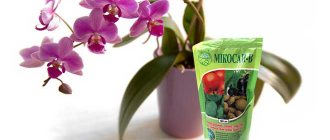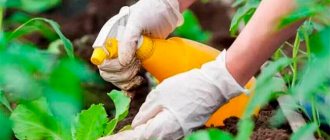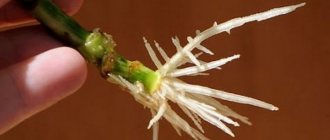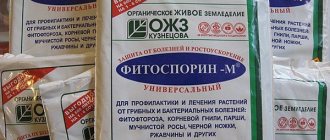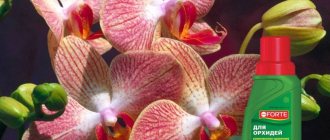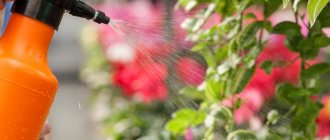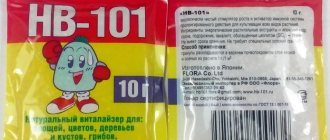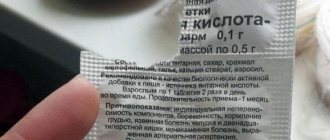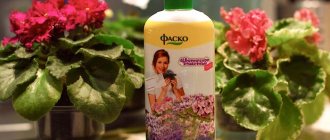Preparation "Maxim" for orchids - description
The fungicide is presented as a water-soluble concentrate, to which a bright pink coloring agent is specially added. This addition allows you to make sure that all the necessary areas of the orchid are treated.
The fungicide is recognized and registered in 5 countries. The active ingredient of the drug is fludioxonil. One liter of the drug contains 25%.
The product is convenient to use: it is available in an ampoule (volume 2 ml and 4 ml) or in a bottle with a measuring spoon (volume 40 ml). The product is also sold in canisters of 1.5 and 5 liters.
Safety precautions
When working with chemicals, a number of important rules should be observed:
- the preparation of the drug should be carried out in a well-ventilated area;
- use personal protective equipment;
- do not allow the fungicide to come into contact with exposed areas of the body;
- use specially designated dishes;
- do not allow the fungicide to enter water bodies;
- thoroughly dry plant materials before planting;
- do not exceed the permissible concentration of the active substance.
Rules for storing the drug:
- shelf life – 3 years;
- permissible temperatures: - 10 - + 35 degrees Celsius;
- store in a place inaccessible to children;
- Do not store near clothing or food.
When working with the drug, the permissible concentration must not be exceeded.
Actions in case of poisoning:
- Provide maximum access to fresh air and contact an ambulance.
- Take activated carbon (1 tablet per 10 kg of body weight).
- In case of contact with eyes, rinse immediately under cold running water without covering them.
Advantages and disadvantages of the drug
Maxim is one of the few drugs whose private use is permitted. This characteristic is its main advantage.
In addition, the fungicide has the following advantages:
- ease of use;
- complete destruction of fungal spores;
- strengthening the immune system of the treated crop;
- low consumption;
- high protection of orchids;
- does not stop plant growth processes;
- fights against a wide range of basal and root rot pathogens;
- does not have a toxic effect on the plant.
The main disadvantage of the drug is its danger to the inhabitants of water bodies, especially fish.
Efficacy of fungicide for orchid disease
Maxim is most effective in the following cases:
- measures to resuscitate an orchid after the development of infectious diseases in an orchid;
- preventative treatment before planting (treating the substrate or soaking the root system).
The product works well against the following diseases:
- Alternaria blight;
- anthracnose;
- phyllosticosis;
- root rot;
- tracheomycosis.
Caring for the plant while using stimulants
After using any root growth stimulator, the plant needs to be provided with comfortable conditions. There are two principles of germination: in a greenhouse and in the air. If the root system is completely dead, preference should be given to a greenhouse.
- To make it, a container is suitable, on the bottom of which a layer of expanded clay should be poured.
- On top you need to lay disinfected with hot steam and cleaned sphagnum.
- The substrate must be moistened and a leaf rosette placed in it. Phalaenopsis should be kept in the greenhouse until the length of new roots is 3-5 cm.
In a container that acts as a greenhouse, it is necessary to maintain air humidity from 70 to 100% and a temperature of at least 22 0C. The duration of daylight hours is from 12 to 14 hours a day.
If a certain number of roots remain, you can do without radically changing the conditions of keeping the flower and plant it in a pot with substrate or a container with water. In the latter case, experienced gardeners recommend adding 1 tsp to the liquid. honey or sugar syrup.
Phalaenopsis should be cared for as follows:
- Maintain indoor air temperature from +23 to +25 0C.
- Ventilate the room regularly to ensure oxygen access.
- An orchid needs a sufficient amount of diffused light.
- Optimal humidity is from 50 to 60%.
- Phalaenopsis placed in a pot should be watered once a week. In the interval between waterings, the substrate should have time to dry.
- Spraying should be done daily.
- Every 10-14 days you need to apply fertilizer based on phosphorus and potassium.
The principle of action of the fungicidal solution
The full mechanism of action has not yet been fully studied by scientists. But numerous studies prove that finylpyrroles can influence the synthesis of components contained in the plasma cell membrane, including the formation of membrane lipids.
Another component of the drug - fludioxonil - is closely related to the processes that occur in the cells of the pathogen even at the moment of membrane transfer - transport of the exciting substance through the membrane into the cell or from it.
During cellular respiration of the fungus, glucose phosphorylation is inhibited, thereby inhibiting sterol biosynthesis.
All these processes cause disruption of the membrane permeability of pathogen cells and their further destruction. The substance is durable, but at the same time it can decompose during photolysis.
How to use Maxim for orchids
The tool may have a different application algorithm depending on the purpose of its use.
Treatment against root rot
The causative agents of root rot are fungi belonging to the genus Fusarium. They are able to penetrate the plant even through miniature damage in the roots.
The disease is aimed at damaging the vascular system of the rhizomes, which subsequently leads to the following diseases:
- root rot - rhizotktonia;
- fusarium wilt;
- black rot followed by the appearance of black mold.
Shower for orchids!
Features of watering orchids. The main disadvantage of the disease is its rapid spread. All affected parts of the orchid become beet pink.
To ensure the greatest effectiveness of the drug Maxim is used as follows:
- Wear protective equipment (gloves and respirators), treat all tools used with alcohol.
- Remove the root system from the substrate and remove all affected parts.
- Immerse the rhizome in warm, clean water for 5 minutes, remove the plant, and allow the water to drain naturally.
- Open a 2 ml ampoule and dilute it in a liter of warm water.
- The used ampoule is placed in a bag and disposed of.
- The solution is stirred well and left for another 5 minutes until completely dissolved.
- Healthy orchid roots are dipped into the prepared solution for 15 minutes.
- Severely damaged parts of the plant are lubricated with undiluted paste from the ampoule.
- After the treatment process, the orchid dries for another day and then is placed in new soil.
IMPORTANT! Only a separate container is used for diluting the product. Under no circumstances should you take food utensils.
Disinfecting the substrate of a new orchid
Sometimes diseases can already be present in the planting soil itself, so it is also recommended to disinfect it before planting.
Dissolve 1 ml of fungicide in a liter of water, stir well and pour the finished product along the edge of the flowerpot. The orchid must be watered with plain water in advance.
Soil treatment before planting
Pre-planting soil treatment will not be superfluous, especially if the substrate components were collected independently.
Processing algorithm:
- The finished collected substrate is filled with water and left for several hours. During this time, all living creatures will come to the surface, and the liquid can be drained. Then the soil is washed several more times with ordinary tap water.
- The well-washed substrate is poured with the prepared product (1 ml per 1 liter of water). You need to prepare enough product so that it completely covers the finished soil.
- The container is covered with black film and left for 48 hours.
- After the specified time, the water is drained and the soil is completely dried.
Disease Prevention
The described fungicide is primarily intended for preventive purposes. This treatment will not harm the orchid, since the drug is non-toxic.
The gardener's priority should be the treatment of living, healthy orchid tissue in order to protect it from attacks by pests and diseases of various types.
For prevention, it is enough to soak the root system of the plant in the solution for half an hour. The concentration is the same as for therapeutic treatment - 1 ml of fungicide per 1000 ml of water.
First aid
Aktara for orchids
At the first signs of acute poisoning, you should stop working, remove the victim from the area affected by the drug, carefully remove clothing and personal protective equipment, avoiding contact of the drug with the skin, and immediately seek medical help. In case of accidental ingestion, rinse your mouth with water, immediately give the victim several glasses of water with a suspension of activated carbon to drink at the rate of 1 g of sorbent per kg of body weight, and then induce vomiting by irritating the back of the throat; this should be repeated several times to more completely remove the drug from the body (vomiting is caused in conscious victims), then again drink a glass of water with activated carbon (1 g per kg of body weight) and immediately consult a doctor
In case of accidental ingestion, rinse your mouth with water, immediately give the victim several glasses of water with a suspension of activated carbon to drink at the rate of 1 g of sorbent per kg of body weight, and then induce vomiting by irritating the back of the throat; This should be repeated several times to more completely remove the drug from the body (vomiting is caused in conscious victims), then again drink a glass of water with activated carbon (1 g per kg of body weight) and immediately consult a doctor.
If inhaled, remove victim to fresh air.
In case of contact with skin, remove the drug with a piece of cloth, cotton wool or soft paper, avoiding rough rubbing of the skin, and then wash the contaminated area with soap and water.
In case of contact with clothing, after removing contaminated clothing or shoes, rinse areas of possible skin contamination with water.
In case of contact with eyes, rinse immediately with a soft stream of clean running water.
After first aid, seek medical help if necessary.
Treatment is symptomatic; there are no specific antidotes.
Reviews
Alexandra: “I’ve been growing orchids for several years now, but I only recently learned about this drug. I read a lot of positive reviews on the forum and immediately decided to try it. I was very pleased with the result. The orchids immediately perked up after treatment.”
Natalya: “For my birthday I decided to buy myself an orchid. The store advised me to immediately take the drug Maxim. After the purchase, I treated the soil and roots. Now the plant is blooming for the second time. So far there have been no problems with cultivation. My friends suggested that the main thing is not to overdo it with concentration.”
